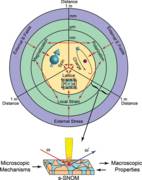Nano-optical imaging and spectroscopy of order, phases, and domains in complex solids
| Reviews and Highlights | Quantum Science | Molecular and Soft-matter | Ultrafast Nano-optics and Nanophotonics | Mineralogy and Geochemistry |
|---|
Joanna M. Atkin, Samuel Berweger, Andrew C. Jones, and Markus B. Raschke
Adv. Phys. 61, 745 (2012).
DOI PDF

The structure of our material world is characterized by a large hierarchy of length scales that determines material properties and functions. Increasing spatial resolution in optical imaging and spectroscopy has been a long standing desire, to provide access, in particular, to mesoscopic phenomena associated with phase separation, order, and intrinsic and extrinsic structural inho- mogeneities. A general concept for the combination of optical spectroscopy with scanning probe microscopy emerged recently, extending the spatial resolution of optical imaging far beyond the diffraction limit. The optical antenna properties of a scanning probe tip and the local near- field coupling between its apex and a sample provide few-nanometer optical spatial resolution. With imaging mechanisms largely independent of wavelength, this concept is compatible with essentially any form of optical spectroscopy, including nonlinear and ultrafast techniques, over a wide frequency range from the terahertz to the extreme ultraviolet. The past 10 years have seen a rapid development of this nano-optical imaging technique, known as tip-enhanced or scattering-scanning near-field optical microscopy (s-SNOM). Its applicability has been demonstrated for the nano-scale investigation of a wide range of materials including biomolecular, polymer, plasmonic, semiconductor, and dielectric systems. We provide a general review of the development, fundamental imaging mechanisms, and different implementations of s-SNOM, and discuss its potential for providing nanoscale spectroscopic including femtosecond spatio-temporal information. We discuss possible near-field spectroscopic implementations, with contrast based on the metallic infrared Drude response, nano-scale impedance, infrared and Raman vibrational spectroscopy, phonon Raman nano-crystallography, and nonlinear optics to identify nanoscale phase separation (PS), strain, and ferroic order. With regard to applications, we focus on correlated and low-dimensional materials as examples that benefit, in particular, from the unique applicability of s-SNOM under variable and cryogenic temperatures, nearly arbitrary atmospheric conditions, controlled sample strain, and large electric and magnetic fields and currents. For example, in transition metal oxides, topological insulators, and graphene, unusual electronic, optical, magnetic, or mechanical properties emerge, such as colossal magneto-resistance (CMR), metal-insulator transitions (MITs), high-TC superconductivity, multiferroicity, and plasmon and phonon polaritons, with associated rich phase diagrams that are typically very sensitive to the above conditions. The interaction of charge, spin, orbital, and lattice degrees of freedom in correlated electron materials leads to frustration and degenerate ground states, with spatial PS over many orders of length scale. We discuss how the optical near-field response in s-SNOM allows for the systematic real space probing of multiple order parameters simultaneously under a wide range of internal and external stimuli (strain, magnetic field, photo-doping, etc.) by coupling directly to electronic, spin, phonon, optical, and polariton resonances in materials. In conclusion, we provide a perspective on the future extension of s-SNOM for multi-modal imaging with simultaneous nanometer spatial and femtosecond temporal resolution.
